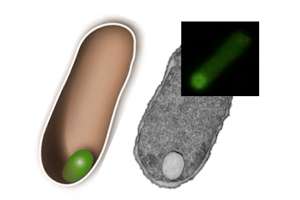Researchers develop genetic blueprint for organelles that give simple cells new functions

A research team including Dr. Stefan Schiller, his assistants Dr. Matthias Huber and Dr. Andreas Schreiber, and further groups from Freiburg and Hungary has refuted a long-held assumption in biology: The scientists have shown that it is not only possible to extend the functions of organelles - organs of the cell - but also to form them from scratch with the help of genetic blueprints. The team published its findings in the journal Nature Materials.
Cells can be classified into two groups: simple cells, like bacteria, and higher cells, such as those of plants, animals, and humans. They differ among other things with regard to their internal structure: Higher cells contain organelles that - like organs in the human body - serve special functions.. Mitochondria, for instance, provide energy, while the lysosomes of animal cells and the vacuoles of plant cells are responsible for breaking down substances.
Organelles are composed primarily of lipids - substances like fats and oils, so-called secondary gene products for which there is no direct blueprint in the genome. Instead, however, the scientists developed an approach using amphiphilic proteins. Like lipids, they have both hydrophilic and hydrophobic parts. Thanks to this property, they can self-assemble to form organelle-like compartments inside the cell. The biosynthesis of proteins can be controlled by a blueprint in the form of plasmid DNA. These double-stranded, usually ring-shaped molecules are present in bacteria, thus enabling them to form synthetic organelles.
The approach opens up new possibilities for the study of biomedical processes as well as for applications in biotechnology, chemistry, and pharmacy. "For the first time ever, we have succeeded in forming a new organelle in the cell and equipping it with functions on the basis of rationally designed protein building blocks. This is a fundamentally new approach for biology, biotechnology, and medicine," says Schiller. With the help of chemical reactions that were previously impossible in the cell, scientists now have new means at their disposal for producing biotechnological products. The chemical industry in particular could utilize the functional extension of bacterial cells to produce important starting materials for which there were previously no biosynthetic strategies and methods available.
More information: "Designer amphiphilic proteins as building blocks for the intracellular formation of organelle-like compartments." Nature Materials 14, 125-132 (2015). DOI: 10.1038/nmat4118
Journal information: Nature Materials
Provided by Albert Ludwigs University of Freiburg





















